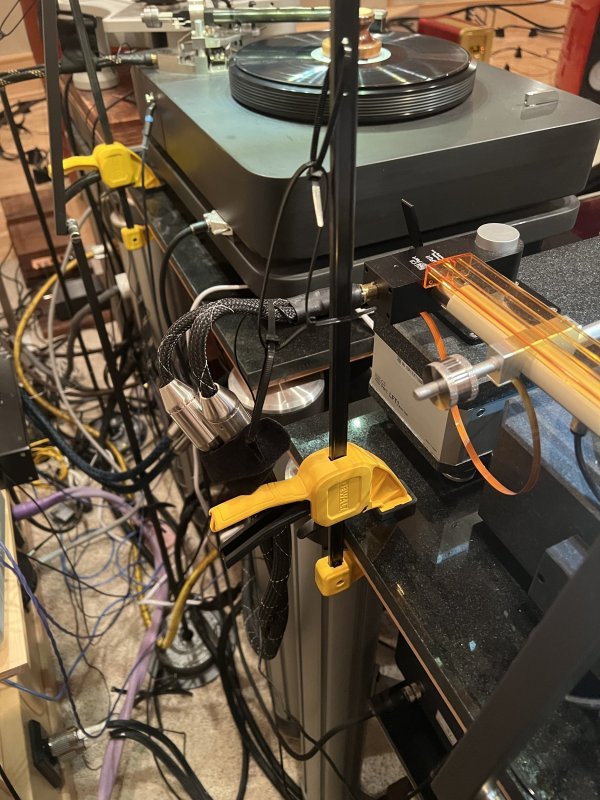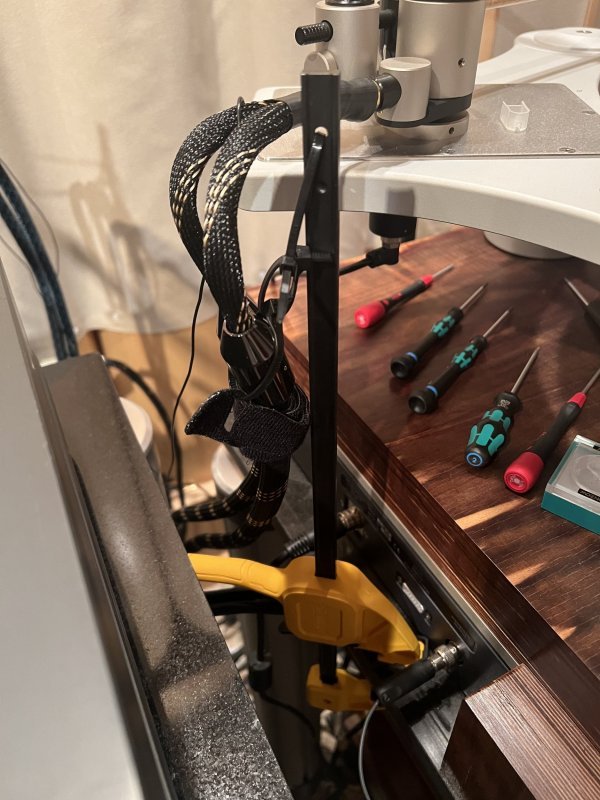Thanks for your insight Mike and Sam, it is always very interesting to read feed back from owners, as these cables and cable enhancers (dongles) will never be available commercially. They were all experimental prototypes that cost millions to develop, headed by Eric Tsang and Richard Bews and to some degree myself. In fact, the cost of R&D (materials only) could never be recovered. Luckily all of the costs were subsidised by the development team.
Enhancers are not a new idea. The concept has been around since 1997 when we started investigating the effects of using large rod-like conductors mixed with smaller conductors to enhance the sound. We found that it was limiting to use just one size of conductor as per the majority of manufacturers. A combination of different numbers and sizes of conductors enabled the sound to be enhanced significantly over the use of single conductors. Some of the LFD cables incorporate enhancers internally, and sometimes use different conductors between enhancers based on extensive R&D extending to thousands of hours of prototyping and listening tests.
The enhancer is essentially a short transmission line approx 2 to 6 inches long, which is designed to improve the sound. Most commercial cables are heavily compromised by the manufacturing practicalities and cost limitations involved in producing a commercially viable product. This results in the majority of internal wire used in commercial cables being of at best good, and often poor, sonic quality. Therefore the enhancer is designed to address these limitations. This is achieved by using different conductors, metals, dielectrics and geometries which can be highly complex. Some of these enhancerss have up 84 different diameters of silver, amorphous platinum and pure gold to get the desired effect. They typically improve detail retrieval, give greater nuance and reduce grain by a significant margin.
Silver is typically described by listeners as a bright but clear conductor, this is because not enough silver material is employed in the commercial cable. Generally the biggest diameter used in almost all cables is less than 2.5 mm squared (typically less than 0.5mm squared) some of the the conductors that we use exceed 30mm, 40mm and just started on 50mm squared in area. By comparison they are absolutely enormous and totally un-bendable, basically solid rods of material. They cannot really be called 'wires' in any sense of the word. Some conductors have to be hand-pulled to get the precise diameter and some of the large dongles could have up to 400 hours of labour in their manufacture. There are many different silver profiles, including ribbon and D shaped conductors, used within the construction. Prototyping also extended to the examination of different annealing times and temperatures and also the effect of using different sheathing materials (Silicon/PTFE). The large size and complexity of the design is important to the enhancement of the sound.
One major improvement that is achieved by the enhancer is the significant reduction of grain that can be associated with very high quality horn loudspeakers and large panel speakers. Incorporating enhancers into these systems can produce a much more realistic and natural presentation of the sound. Many box speakers are heavily compromised due to the compromises made in their drivers and internal wiring. Listening tests have shown that they can be dramatically improved with the use of the right cables, enhancers and good equipment.
Mike's set up uses a semi commercial enhancer called the Cobra Tail. This allows large silver round and d conductors to be connected to a 5 pin din tonearm connector. This enables the use of very large interconnect cables which would otherwise be too big to use as a tonearm cable. Most tonearm cables, especially silver ones, do not use enough conductor material, hence why many commercial copper cables sound more preferable even though they have have significant amounts of grain. They have a sense of bass foundation and represent a cheaper and easier option. Most cheap inexpensive copper cables make a reasonable compromise when compared against expensive small silver tonearm cables. However, the Cobra tail has proven that even with the extra connections and conductors, a superior sound can be achieved again and again opening up the use of other large interconnect cables. The majority of audiophiles have never heard what is possible with this ultimate development, as it is too labour intensive and expensive for commercial production.
There is a lot to this and some of the ideas were inspired by the work of Yammamura, but taken in a direction we felt achieved very good results. The quest will always continue, limited only by the depletion of our wallets and the availability of resources, (not to mention all the time involved in making them). We have come to the conclusion that we will never be able to recover our costs.
One might say, "Why bother???" but then we would not progress in terms of sound quality. In the same way it could be said, " Why bother with improving turntables electronics and loudspeakers???" but at least those items can be visually appealing. Unfortunately enhancers are less sexy and impressive visually. But they can be more important, as just upgrading system components will still result in the system being limited by the interconnects used. The improvements made by enhancers cannot be achieved by other methods, and they are just as fundamental a part of the overall system as the source, amps, speakers and cables.
I have often sent people videos of enhancer changes and have been told it sounds equivalent to a huge component upgrade. As soon as one tells them what it actually is, they are not sure what to believe. I would not waste my own money and time pursuing this avenue of research unless there were significant sonic improvements to be achieved within high-end systems.
I am convinced that dongles can produce a much more realistic and natural presentation of the sound. Listening tests have shown significant improvements with the use of the right cables and enhancers. The proof comes from the listening, and if you are lucky enough to listen to the effect of 'dongles' in high end systems, you will be convinced in a heartbeat.
















